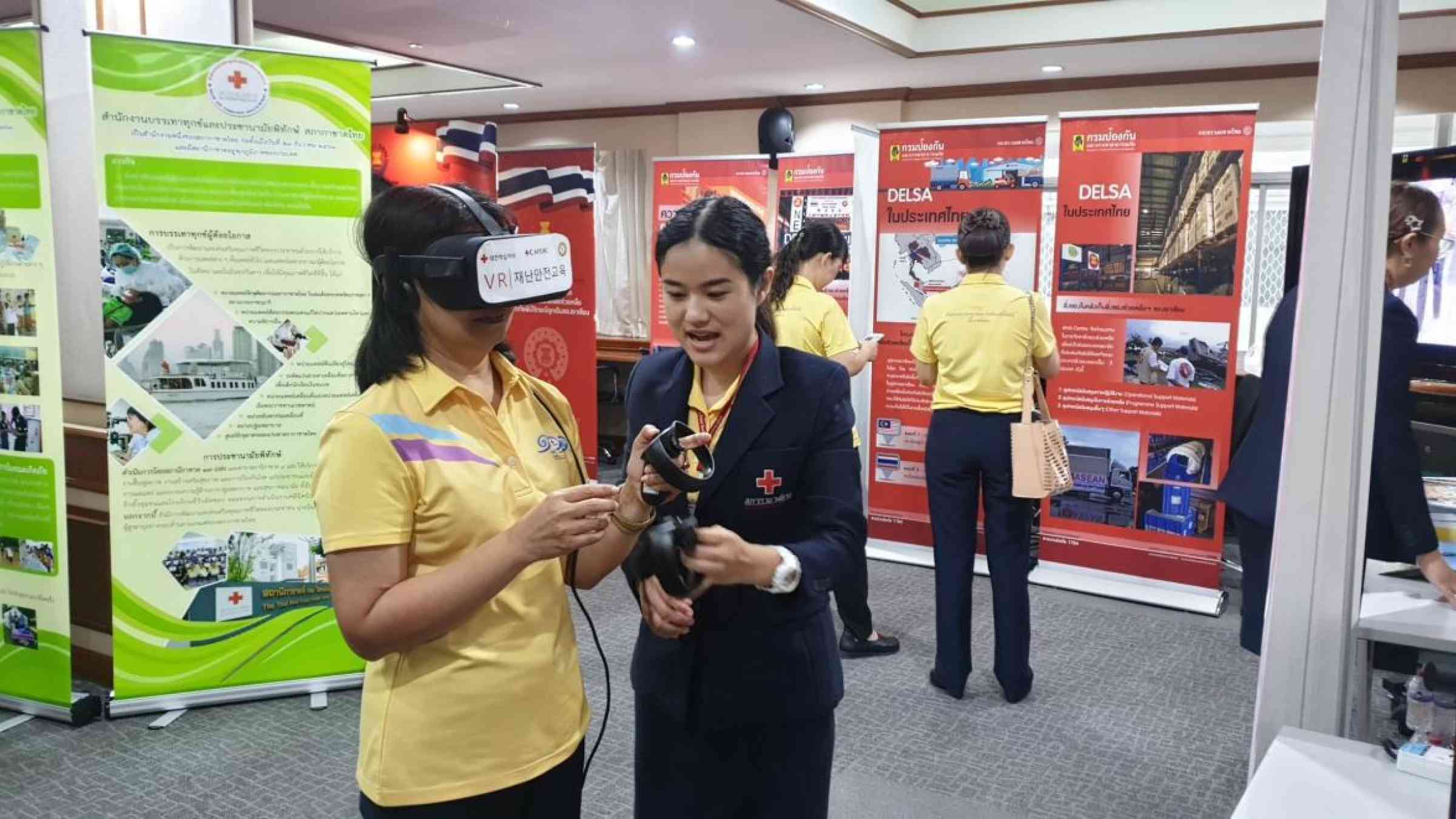Thailand: Infrastructure resilience at the cornerstone of risk-informed development

Thai Red Cross, one of the sponsors of the event, showcased a virtual reality simulator that teaches people how to safely navigate a fire outbreak (source: Thai Red Cross)
BANGKOK, 12 October 2019 – As one of the first countries in the region to mark the International Day for Disaster Risk Reduction, the Government of Thailand took advantage of the occasion to highlight how it is working with partners to build the resilience of its infrastructure.
In its 30th year of celebration, this year's International Day for Disaster Risk Reduction, observed on 13 October, focuses on reducing disaster damage to critical infrastructure and disruption of basic services. It highlights the importance of investing in disaster resilient infrastructure, which is relevant to the achievement of the Sendai Framework for Disaster Risk Reduction, underpins many of the Sustainable Development Goals, and is key to protecting against the effects of climate change.
Thailand, like many countries in the region, is uniquely positioned to take advantage of the dividends offered by resilient infrastructure given the tremendous growth it has experienced in its construction sector due to increasing urbanization and economic growth.
As the Chair of Association of Southeast Asian Nations (ASEAN) for 2019, Thailand’s commemoration event also celebrated the ASEAN Day for Disaster Management. The event was organized by the Ministry of Interior’s Department for Disaster Prevention and Mitigation (DDPM), which has the lead for promoting disaster risk reduction and risk-informed development within the Thai government. A close partner of the UN Office for Disaster Risk Reduction, the DDPM sought to highlight its multi-partner and multi-sectoral approach to building infrastructure resilience.
Praising the participation of many partners, Mr Chainarong Vasanasomsithi, the Deputy Director-General of DDPM, said in his opening remarks: “For disaster risk management to be successful, they require the strong cooperation that we have here today,” adding that “the event today is a good opportunity for the relevant network partners to share knowledge, activities and projects that have been implemented to create safety in schools, hospitals, and communities.”
Investments in infrastructure have reached a record level globally, and Asia is expected to need investments of USD 1.7 trillion per year in infrastructure to maintain its growth trajectory. Thailand is no exception as it has become an upper middle-income country over the last few years with the second largest economy in Southeast Asia. From being a predominantly rural economy, more people now live in the urban areas than in the rural areas. Poverty levels have declined substantially over the last 30 years. Such a rapid transformation puts pressure on existing and increases demand for new infrastructure.
However, not all of its infrastructure investments are built to be resilient. This puts its development gains at risk from disasters. Asia is estimated to bear direct physical losses of USD 126 million per day as a result of extreme weather events and geophysical hazards.
“Thailand is in the midst of an economic transformation. However, unplanned development, climate change, and hazards like earthquakes, are all risks that Thailand faces. Countries must invest to protect against the disaster risk or pay an even heavier price later. The benefits of investing in resilient infrastructure outweigh costs by a ratio of 4 to 1. Yet, resilience is not an add-on to development – we cannot construct a building and then make it resilient. For the resilience dividend to be realised, risk must be embedded into the development planning and processes,” said Dr Animesh Kumar, Deputy Chief of the UNDRR Regional Office and one of the key speakers at the event.
To accelerate this, UNDRR highlighted the potential role of the Coalition for Disaster Resilient Infrastructure, led by the Government of India with support from UNDRR and other organisations. Launched at the Climate Action Summit this year, the Coalition will function as a multi-country and multi-stakeholder partnership on thematic areas like risk assessments, infrastructure resilience standards, financing and recovery and reconstruction.
The event featured various activities organized by partner organizations, such as a knowledge exchange forum, several quiz games, a room-sized earthquake simulator, a virtual reality simulator, and Bangkok Metropolitan’s mobile disaster knowledge car.
Sponsors and organizers of the event included the Thai Red Cross, Bangkok Metropolitan Administration, Thai PBS Television Station, Thai Insurance Association Civil Society, UNDRR, the UN Development Programme, World Vision Thailand, the Asian Disaster Preparedness Centre, Plan International, Stockholm Environment Institute, and the School Road Safety Club.
Explore further
Also featured on
Is this page useful?
Yes No Report an issue on this pageThank you. If you have 2 minutes, we would benefit from additional feedback (link opens in a new window).